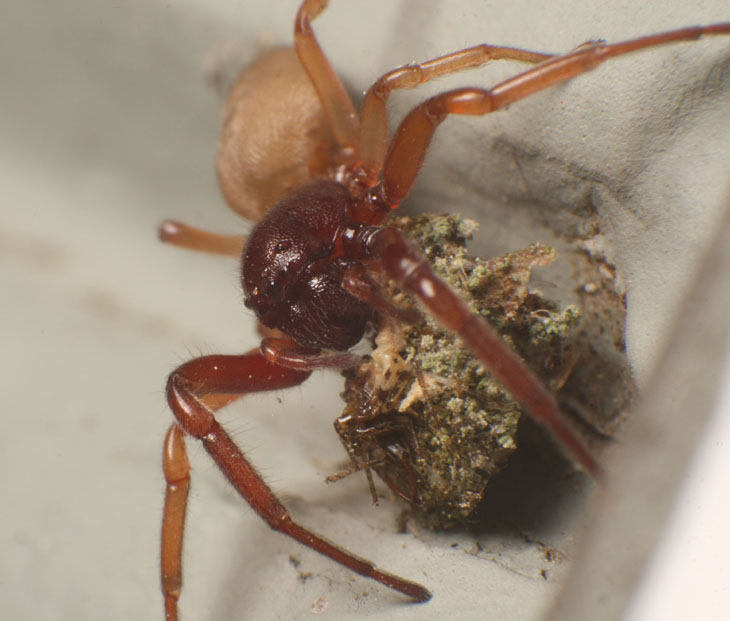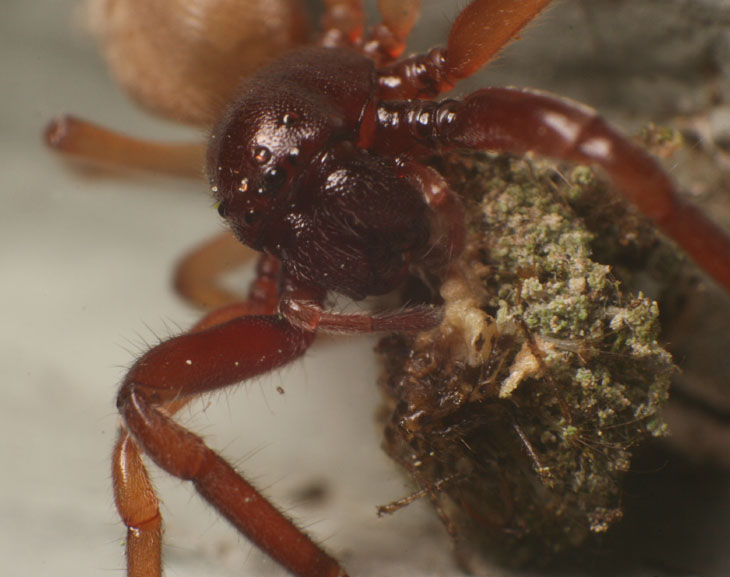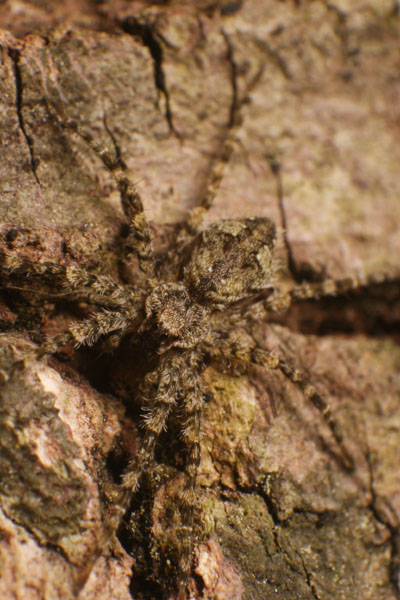
Actually, you can run if you want, and you may, because the image above is the least icky – it’s all downhill from here. You should know I don’t say that lightly…
What you’re seeing here is the larva of a green lacewing fly, family Chrysopidae, bearing the typical camouflage for this time of year, which is a nice coat of lichen – the background surface is my palm, to give a faint sense of scale. This variety of lacewing has a set of extra appendages along its back, little tree-like structures, to which it can attach things to hide its true nature from predators – I’ve seen them covered with chaff, and molted exoskeletons of other species, and once even a dead ant (very punk, that one,) but none of that is available right now, so it’s lichen. Lichen, however, is not particularly ambulatory, nor does it grow in neat little patches like this, so the species is not hard to find if you’re so inclined, and I sought out this particular one for the illustration.

Here’s a peek behind the curtain; the head is to the right, and you can see its long, reddish-brown chelicerae, with a small cluster of eyes near the base and some of the striping on the head – remember this, because you’ll need it to identify something in just a second. The real meat of the post is the tableaux I spotted last night, realizing what I was seeing and trotting in to get the camera. Yes, we’re off on the whole spider thing again – I don’t try to do this, I really don’t, but they’re what I spot most often.

The camouflage only works so well, and it’s largely a visual thing, which doesn’t always work on anything that hunts by something other than sight. Near as I can determine, this is a species of ground spider, family Gnaphosidae, and its lacewing prey is sitting belly-up, head at lower left. The chelicerae are pointing almost straight down, with the forelegs bunched under the ‘chin.’ But naaah, that’s not close enough, so let’s get a slightly better view.

This is a nice illustration of the spider’s eye pattern, which is one of the more dependable ways of identifying spiders, with a bit of reflection from the two at top center, and the faintest hint of the spider’s own chelicerae can be seen just under that walrus mustache. The mustache is misleading, however, since this is a female. What can also be seen, with a close examination, are two of the appendages that the lacewing attaches its camouflage to – find the dark straight line of one of its forelegs, stretching across the lichen to the right, and you can see the little arms at either end of the leg segment, ends splitting into very fine branches. If I’d witnessed the capture, I might have been able to tell you how the spider knew it was a meal, but all I saw was this, so I’m just going to guess it was movement that triggered the capture.
 Last night was quite warm as a front pushed in, so I was prowling around to see what could be found. This one is probably a wolf spider (family Lycosidae,) with a slim possibility of being a wandering spider (family Ctenidae) – I can’t see the eye pattern well enough in any of the frames I took, but there’s only a handful of species of the latter and scads of the former, so I’m favoring wolf right now. The camouflage against the tree bark was great, and I’m not even sure how I spotted this one, but it might have been because it moved. With legs fully spread it could still sit on your thumbnail without overlap, so not exactly an imposing specimen.
Last night was quite warm as a front pushed in, so I was prowling around to see what could be found. This one is probably a wolf spider (family Lycosidae,) with a slim possibility of being a wandering spider (family Ctenidae) – I can’t see the eye pattern well enough in any of the frames I took, but there’s only a handful of species of the latter and scads of the former, so I’m favoring wolf right now. The camouflage against the tree bark was great, and I’m not even sure how I spotted this one, but it might have been because it moved. With legs fully spread it could still sit on your thumbnail without overlap, so not exactly an imposing specimen.
The headlamp was turning up the occasional blue star reflection on the ground indicating spiders, but they were exceptionally shy, I’m guessing from it still being early in the season, and I could never get close to any. It’s a shame, because they were all much bigger than this one and would have made for much creepier images – hey, if I’m gonna do it, I might as well go whole hog, right? But don’t fret – there’s still plenty of time. In fact, I might have obtained a new way to step up my Creepy Game, but I’m not sure yet and don’t want to get you all excited for nothing.

Yet another small one, but this one was captured and photographed in ‘studio’ conditions, so while doing that I was able to get specific measurements as it obligingly held quite still in this position – it’s 13mm in length overall, from leg tip to leg tip, but only 3mm in body length. I believe this to be a longlegged sac spider species, family Cheiracanthium, but again, not sure. I’ve tried asking them but they all remain silent, waiting on their attorneys no doubt. But yes, one of those eyes produced a reflection from the flash.
 And another view, because I could – I like the legs stretching towards the corners and going well out of focus, and I’m wondering if it produces an ominous, reaching-for-you feel to anyone out there. One of these days I’ll try to produce a ‘stacked’ image getting the whole thing in focus, by shooting a series of images focused at different points along the body and stitching them together, but that will be a serious staging issue and I’m not sure how much it’s really worth it. The easiest way would be to have a sliding stage that the subject sits upon, since tracking focus/zoom at this magnification is difficult – the lens action is too sticky, meaning the camera can be jiggled easily from its position, even on a tight tripod. Something nice and smooth in operation like a microscope stage would be ideal, but I have yet to run across one of those to scavenge for stuff like this.
And another view, because I could – I like the legs stretching towards the corners and going well out of focus, and I’m wondering if it produces an ominous, reaching-for-you feel to anyone out there. One of these days I’ll try to produce a ‘stacked’ image getting the whole thing in focus, by shooting a series of images focused at different points along the body and stitching them together, but that will be a serious staging issue and I’m not sure how much it’s really worth it. The easiest way would be to have a sliding stage that the subject sits upon, since tracking focus/zoom at this magnification is difficult – the lens action is too sticky, meaning the camera can be jiggled easily from its position, even on a tight tripod. Something nice and smooth in operation like a microscope stage would be ideal, but I have yet to run across one of those to scavenge for stuff like this.
Anyway, there’s your spider fix. I’m still watching for any other subjects, but it seems I’m destined to find mostly arachnids. It’s probably something karmic.




















































